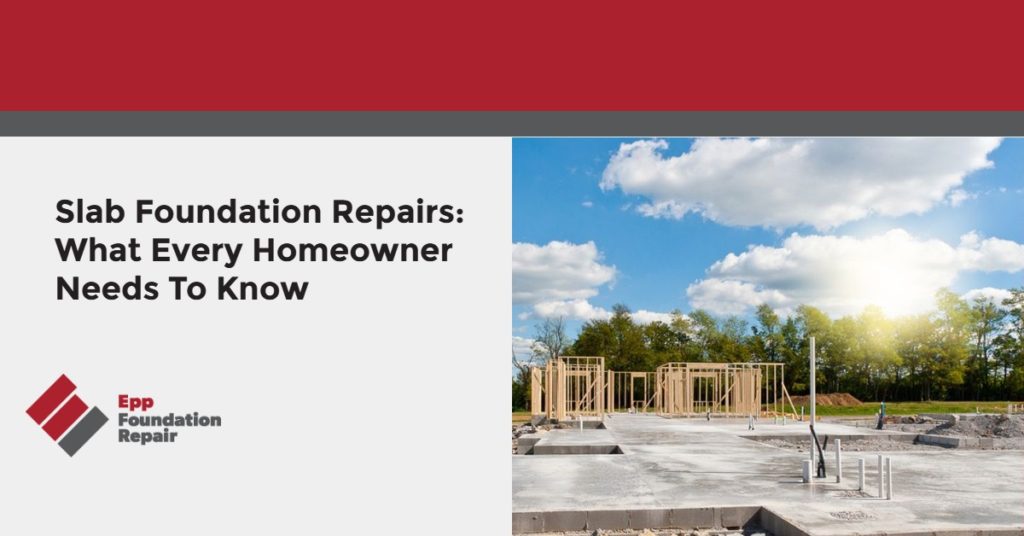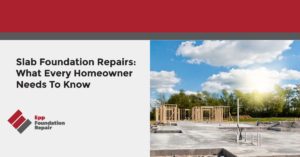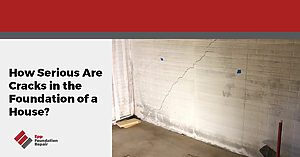Looking for information about slab foundation repairs? We’ve got the basics here in this article, including the definition of a slab foundation, what causes problems in slab foundations, slab foundation repairs (methods and cost), signs you might have a foundation issue, and how you can prevent problems with your slab foundation.
What Is a Slab Foundation?
A slab on grade foundation is a concrete slab – around 4-6 inches thick – that sits directly on the ground and has no basement or crawl space underneath it. While slab foundations are less expensive than other types of foundations, they can be inconvenient. For example, if you have a problem with your plumbing, the repair contractor will need to put a jackhammer to the slab to access the pipe. Compare that to the ease of access provided by both basement and crawl space foundations.
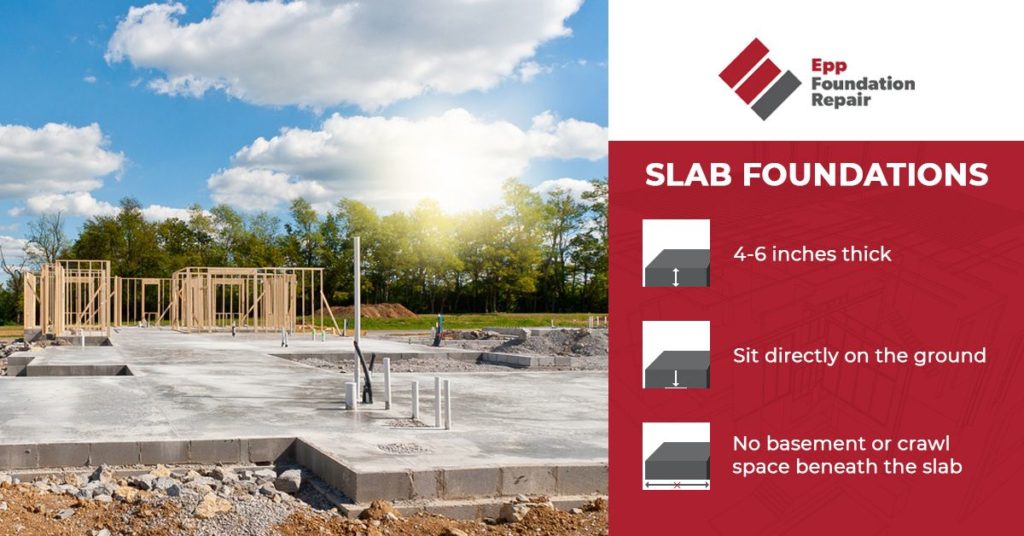
What Causes Problems With Slab Foundations?
Believe it or not, most foundation problems are caused by water, either too much or too little of it in the soil. Water is especially problematic for foundations (all types) built on top of expansive soil. (Expansive soils are those that swell as they absorb moisture and then shrink by that same amount when they dry out. This creates movement, which puts stress on a foundation and will eventually lead to structural damage.)
Poor drainage can also lead to hydrostatic build-up in the soil under the foundation. If this happens, the pressure will push against the slab from below and cause problems.
Slab foundations built on top of expansive soil will experience movement due to seasonal changes in soil moisture levels. This happens because, as we mentioned above, expansive soil swells as it soaks up moisture and shrinks when it dries out. Over time, this movement in the soil will cause foundation damage, including differential foundation settlement.
Other causes of slab foundation problems include,
Soil that wasn’t adequately compacted before construction – When soil isn’t compacted before construction begins, it will compact – probably unevenly – after the house is built. This uneven foundation settlement is referred to as “differential settlement,” which can cause significant foundation damage. (See the graphic below.)
Frost heave – In colder climates, soil freezes, expands and pushes against the slab from below.
Invasive tree roots – Large tree roots can both push against a foundation and drink up moisture in the soil. Voids can form in the dry soil left behind and destabilize the foundation.
Natural disasters such as earthquakes, floods, droughts, and sinkholes.
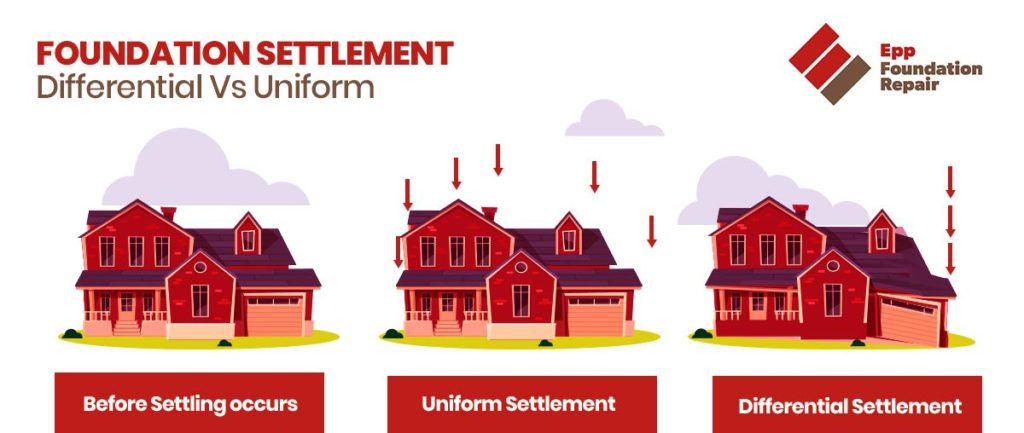
Slab Foundation Repairs: Most Common Methods
Helical piers or push piers are the two most common repair solutions for slab foundations experiencing differential foundation settlement. They take the structure’s weight and transfer it to load-bearing soil.
The chosen underpinning solution depends on the weight of the structure, and helical piers are the usual choice for lighter buildings. After the home has been underpinned using either helical or push piers, polyurethane foam is often used to fill any remaining voids under the slab.
How helical piers work
Helical piers – which look something like giant screws – are turned into the ground until they reach the required depth. Once they’re in place, synchronized hydraulic jacks lift the building back up. Installation is quick and minimally invasive.
How push piers work
Steel brackets are first attached to the bottom of the foundation. Push piers are then driven down through the brackets until they reach the load-bearing strata. After the push piers are in place, a synchronized hydraulic lifting system lifts and levels the structure. Like helical piers, push pier installation is both fast and minimally invasive.
How Much Do Slab Foundation Repairs Cost?
The cost to fix a slab foundation using piers (i.e., underpinning) depends on where you live, the type and severity of the problem, and the number of piers used. In our service area in Nebraska, Iowa, Kansas, and Missouri, the total cost could be anywhere from $5,000 – $30,000.
Common Signs Of Slab Foundation Trouble
Signs your home might have foundation trouble include,
- Windows and/or doors that are hard to open and close – If this is just one window or door, it might not be a sign of foundation trouble. However, if most or all of your windows and/or doors have problems, you probably have a foundation issue.
- Sloped, uneven floors
- Ceilings and floors that are no longer attached to the walls – Even slight separations are a sign of foundation issues.
- Floor cracks – If the crack is limited to one or two tiles, this probably isn’t a foundation issue. Perhaps something was dropped on the floor. However, wall-to-wall cracks are a sign of foundation trouble.
- Bowed walls – Walls can be bowed with or without cracking.
- Cracked walls – Horizontal cracks especially are a sign of structural damage.
- Torn wallpaper – Torn wallpaper could be a sign the wall behind the wallpaper is cracked.
- Diagonal cracks that start at the corners of doors and windows and spread out toward the ceiling.
- Moldings that have separated from the wall or ceiling
- Stair step cracks in brickwork
- Chimneys or porches that are leaning away from the house
How To Prevent Slab Foundation Problems
Since water causes most foundation problems, groundwater control is essential. Here are a few things you can do,
- Keep your gutters free from debris – Clogged gutters can cause rainwater to spill over the side of your home and down into the soil around the foundation.
- Install downspout extensions if necessary – Downspouts that are too short dump water next to the foundation. An extension will take this water and channel it away from the foundation.
- Install an underground downspout and sump pump discharge extension – These are often referred to as “bubbler pots.” They take the water coming down off your gutters and direct it to an underground downspout that leads away from the foundation and into a small sump pump in your yard somewhere. When the sump pump is full, the lid pops up and releases the water.
- Regrade your yard – Your yard should slope away from your foundation. Both landscapers and foundation repair professionals can help you with yard regrading.
- Install interior and/or exterior drain tile – A drain tile system will take excess water in the soil and channel it away from the foundation, either via gravity or a sump pump. If you want a dry basement, a drain tile system is essential unless you live in an arid climate. If your home is relatively new, it might already have a drain tile system. However, both exterior and interior drain tile systems can be installed in older homes.
Learn more about: The importance of window wells
If you have a problem with your home’s slab foundation, don’t delay. Slab foundation repairs will only get more expensive the longer you wait. If you’re in our service area in Nebraska, Iowa, Kansas, and Missouri, contact us today for a repair estimate.

